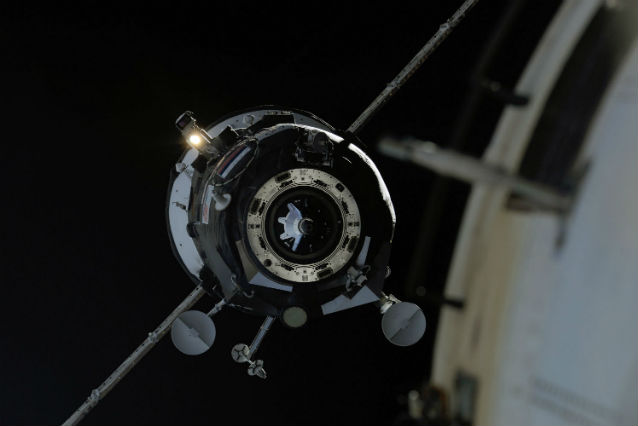Russia’s space programme has had a bad recent run, with an unmanned International Space Station (ISS) resupply ship left spinning out of control, the failure of an experimental military launcher and the apparent cancellation of a super-heavy-lift rocket programme owing to swingeing budget cuts.
Federal space agency Roscosmos looks set to lose 35% of its budget over the next 10 years, with spending cut over the decade to about Rb2 trillion ($37.7 billion), according to a Reuters report carried by The Moscow Times. Lost in those cuts will be a super-heavy-lift rocket programme – and Russian plans to orbit its own space station from 2023 may also be in doubt.
Russia’s government is facing a financial squeeze and looming recession, with low crude prices hitting oil revenues and Western sanctions laid down over the crisis in Ukraine starting to bite.
A Progress mission to resupply the ISS went irretrievably wrong soon after launch on 28 April, when navigational antenna failed to deploy – leaving Russian ground controllers unable to command the ship. Meanwhile, the US Air Force Joint Space Operations Center at Vandenberg AFB reported that its radar had “observed 44 pieces of debris in the vicinity of the resupply vehicle and its upper stage rocket body”.
A launch failure on 22 April saw a 9.6t “experimental solid-fuel rocket carrying metrical equipment” clear the pad at Plesetsk spaceport, inside the Arctic Circle. It then “strayed off trajectory” and crashed to the ground with no injuries, according to state news agency Tass.

A successful Progress approach to ISS
NASA
But while occasional failures are to be expected, the budget cuts pose a real crisis for Russia’s space programme. Roscosmos could not be reached to elaborate, but the launcher in question would appear to be the heaviest version of a modular system called Angara, which is intended to replace the failure-prone Proton. In December 2014, the Angara A5 – capable of lifting 25t to low-Earth orbit – made a successful maiden flight from Plesetsk. The smallest variant in the family, Angara 1.2PP, flew five months earlier. A 35t variant was also planned.
AMBITIONS
Very heavy launch capability has become a key element in Russia’s space policy. The nation has been building a new launch complex in the east of the country, at Vostochny, with the intention of hosting operations that currently fly from Baikonur in Kazakhstan – the launch site for Sputnik, Yuri Gagarin and, currently, all astronauts travelling to the ISS. As the most southerly site in the old USSR and surrounded by sparsely-inhabited terrain, Baikonur was an obvious choice for rocket launches, which are ideally carried out as near as possible to the equator to gain energy from the Earth’s rotation.
Vostochny is not so well situated, but offers the security advantages of being inside Russia.
The 25t Angara 5 may be sufficient to push satellites to the highest geostationary orbits. However, plans to fly Angara from Vostochny later this year – with manned Soyuz flights expected from 2018 – look to be in doubt. Construction has been dogged by stoppages, with some workers reportedly on hunger strike, unpaid for months by a contractor in financial difficulty. Tass also cites reports that claim Rb50 million has been embezzled from the project.
The budget situation also casts uncertainty over Russia’s long-term participation in the ISS. The USA has declared its intention to extend its financial support for the station to 2024, and partners Europe, Russia, Canada and Japan are considering following suit; the current agreement runs out in 2020.
But NASA is understood to be making contingency plans for Russia’s outright withdrawal from the ISS – which at an extreme could mean that it detaches its modules and uses them to start its own station. It has talked of launching new modules later this decade, and possibly holding them in orbit as building blocks for a Russian station of the 2020s, rather than attaching them to the ISS.
Confusing the issue, Russia announced in March that it has agreed to work with the USA on a new station after the current one reaches the end of its life – as far off as 2028, from a pure engineering perspective – but the USA made no corresponding declaration.
MARS
In any case, US interest in a space station beyond 2024 must be called into doubt. NASA is basing its budget planning for a mid-2030s manned mission to Mars on the assumption that money freed by a winding-down of the ISS in the early to mid-2020s would assist preparatory work.
NASA is relentlessly publicising its development of a deep-space-capable manned launch system, as well as an asteroid capture mission planned for the 2020s and research into space medicine and astronaut physiology, as steps on a “journey to Mars”. But quite apart from the daunting technological challenges of keeping a crew alive and supplied on a minimum 18-month round trip, money is a major obstacle. The agency is less publicly insisting that any Mars mission depends on the participation of many international partners, a challenge underscored by the difficulties of reaching agreement even to fund the ISS through 2024. Russian space austerity would only exacerbate that challenge.
NASA’s annual budget has stood at a little more than $17 billion for years now, from which it funds a wide range of space missions as well as aeronautics research. The agency is making no estimates of the cost of a Mars programme, assumed to launch in 2035, but for comparison the ISS is estimated to have consumed some $150 billion from all partners in the 30 years since conceptual work began.
Source: FlightGlobal.com
















